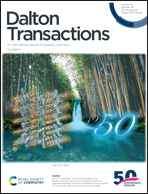Design and synthesis of three new copper coordination polymers: efficient degradation of an organic dye at alkaline pH†
Abstract
Three new coordination polymers (CPs) based on Cu(II), namely {[Cu6(H2L)4(4,4′-bpy)6(H2O)2]·16H2O}n(1), {[Cu(H3L)(1,4-bib)]·3H2O}n(2), and {[Cu2(H2L)2(1,4-bib)2][Cu(1,4-bib)(H2O)2]}n·4nH2O(3) (H5L = 6-(3′,4′-dicarboxyphenoxy)-2,3,5-benzene tricarboxylic acid, 4,4′-bpy = 4,4′-bipyridine and 1,4-bib = 1,4-bis(1H-imidazol-1-yl)benzene) were synthesized under hydrothermal conditions and characterized. 1 adopts a three-dimensional structure and can be described with the point symbol {4·52}2{42·54·64·83·92}{5·104·12} whereas 2 shows a layered structure. 3 can be perceived as a complex salt of two coordination polymers: the cationic component [Cu(1,4-bib)(H2O)2]n2+ (3a) represents a chain polymer and the second anionic moiety [Cu2(H2L)2(1,4-bib)2]n2− (3b) corresponds to a 2D sub-structure. In the presence of H2O2, all complexes 1–3 act as efficient photocatalysts for the degradation of the dye methylene blue (MB). The effects of properties such as initial MB concentration, catalyst dosage, pH value, and H2O2 concentration on MB degradation were also investigated and analyzed in detail. Compounds 1–3 exhibit excellent structural stability during the catalytic process and can be reused at least three times. The hydroxyl radical (OH˙) and holes (h+) were confirmed as the main active species in the degradation process.



 Please wait while we load your content...
Please wait while we load your content...